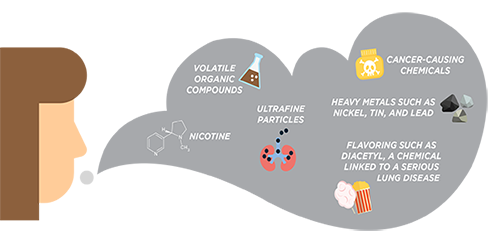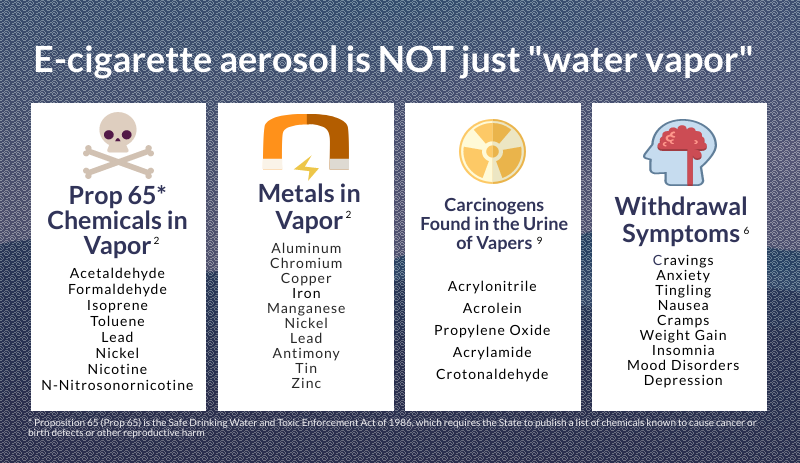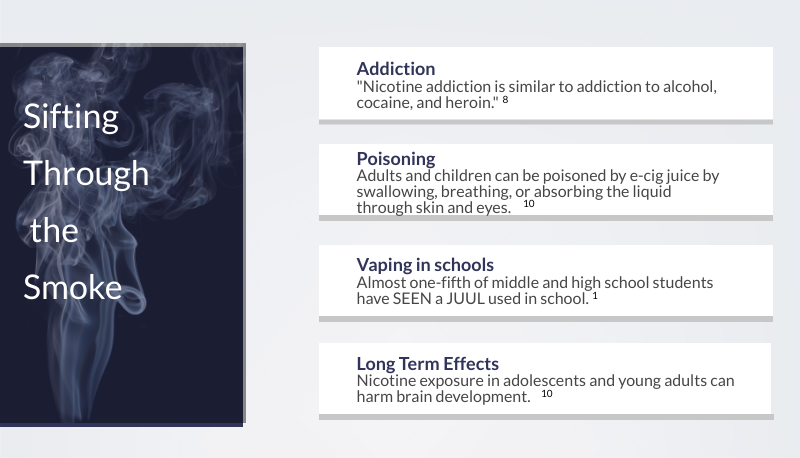About e-cigarettes
E-cigarettes are electronic devices, or electronic nicotine delivery systems (ENDS), that deliver nicotine via a chemical aerosol that is inhaled by the lungs. They are commonly referred to as e-devices, e-pens, e-hookahs, vapes, vape pipes, vape pens, dab pens, dab rigs, mod pods, mods, JUULS, juice, and cigalikes. They come in a variety of brands, sizes, shapes, and flavors.
E-cigarette aerosol is NOT water vapor
The chemical aerosol is created from a liquid, or juice, that is made of nicotine, glycerin, propylene glycol, and other flavorings and unknown ingredients. The aerosol contains harmful chemicals such as nicotine, volatile organic compounds, heavy metals, cancer-causing chemicals, flavorings known to cause disease, and ultrafine particles that can block airways.10

Image source: CDC website
Many have been led to believe that the e-cigarette aerosol is a water vapor. This is just not true. Proposition 65 (Prop 65) is the Safe Drinking Water and Toxic Enforcement Act of 1986, which requires the State of California to publish a list of chemicals known to cause cancer, birth defects, or other reproductive harm. Chemicals on the Prop 65 list have been found in the e-cigarette aerosol, such as acetaldehyde, formaldehyde, isoprene, toluene, lead, nickel, nicotine, and N-nitrosonornicotine.2 Metals have also been found in the aerosol. They include aluminum, chromium, copper, iron, manganese, nickel, lead, antimony, tin, and zinc.2

In addition, cancer causing chemicals, also known as carcinogens, have been found in the urine of people who vape or use e-cigarettes. These carcinogens include acrylonitrile, acrolein, propylene oxide, acrylamide, and crotonaldehyde.9

Watch: Testing the vaping aerosol, a demonstration
Aerosol inhaled from an e-cigarette is not only water vapor. It contains chemicals that are dangerous to health. This short video shows the difference between e-cigarette aerosol and the water vapor produced in a shower using a common air quality meter.
How harmful is the liquid in e-cigarettes?
- A nicotine dependence is similar to an addiction to alcohol, cocaine, and heroin.8
- Adults and children can be poisoned by the e-cigarette liquid, or juice, by swallowing, breathing, or absorbing it through the skin and eyes.10
- Nicotine can harm brain development in adolescents and young adults.10
- 3 out of 10 teens who vape start smoking cigarettes, cigars, or hookahs within six months.7

Facts about e-cigarette labeling
- 9 out of 10 e-cigarettes sold in the United States contain nicotine.5, 3
- When tested, some products labeled as 0% nicotine (no nicotine) actually did contain nicotine.10
- Over half of teens think they are only vaping "flavoring."3
- 6 out of 10 JUUL users did not know that this brand of e-cigarettes contained nicotine.7
Learn more about e-cigarettes
- Pediatric Environmental Health Specialty Unit (PEHSU): www.pehsu.net
- Youth Tobacco Cessation Collaborative: www.youthtobaccocessation.org
- American Lung Association: www.lung.org
- SmokeFree: www.smokefree.org
- National Institute on Drug Abuse: www.drugabuse.gov
- Centers for Disease Control and Prevention: www.cdc.gov/tobacco
- Tips for talking to your child: https://e-cigarettes.surgeongeneral.gov/documents/SGR_ECig_ParentTipsheet_508.pdf
- More tips for talking with your child about vaping: e-cigarettes.surgeongeneral.gov
- Free digital quit programs, such as "This Is Quitting" and "Become An Ex": www.truthinitiative.org/quitecigarettes
Downloadable handout
The “How Safe Is Vaping for Teens” resource on e-cigarettes and vaping is available for download and distribution.
References
- 6 important facts about juul. (2018). Retrieved from https://truthinitiative.org/news/6-important-facts-about-juul
- Cheng, T. (2014, May 23). Chemical evaluation of electronic cigarettes. Tobacco Control, ii11-ii17. http://dx.doi.org/10.1136/tobaccocontrol-2013-051482
- Johnston, L. D., Miech, R. A., O'Malley, P. M., Bachman, J. G., Schulenberg, J. E., & Patrick, M. E. (2018). Monitoring the Future national survey results on drug use; 1975-2017: Overview, key findings on adolescent drug use. [http://www.monitoringthefuture.org/pubs/monographs/mtf-overview2017.pdf]. Retrieved from Ann Arbor: Institute for Social Research, The University of Michigan
- Kann, L., McManus, T., Harris, W. A., Shanklin, S. L., Flint, K. H., & Queen, B. (2018). Youth risk behavior surveillance- United States, 2017. MMWR Surveill Summ, 67(8), 32-38. Retrieved from https://www.cdc.gov/healthyyouth/data/yrbs/pdf/2017/ss6708.pdf
- Marynak, K. L., Gammon, D. G., Rogers, T., Coats, E. M., Singh, T., & King, B. A. (2017, April 11). Sales of Nicotine-Containing Electronic Cigarette Products: United States 2015. American Journal of Public Health, 107, 702-705. http://dx.doi.org/doi: 10.2105/AJPH.2017.303660
- McLaughlin, I., Dani, J., & De Biasi, M. (2015). Nicotine withdrawal. In D. Balfour & M. Munafo (Eds.), The neuropharmacology of nicotine dependence, pp. 99-123). http://dx.doi.org/10.1007/978-3-319-13482-6_4
- National Institute on Drug Abuse. (2016). Teens and e-cigarettes[Infographic]. Retrieved from www.drugabuse.gov/related-topics/trends-statistics/infographics/teens-e-cigarettes
- Orleans, C. T., & Slade, J. (Eds.). (1994). Nicotine. Nicotine addiction: Principles and management(p. 1221). New York, NY: Oxford University Press.
- Rubinstein, M. L., Delucchi, K., Benowitz, N. L., & Ramo, D. E. (2018, April). Adolescent exposure to toxic volatile organic chemicals from e-cigarettes. Pediatrics,141(4). Retrieved from http://pediatrics.aappublications.org/content/141/4/e20173557.short
- Smoking and tobacco use. (2018). Retrieved November 27, from www.cdc.gov/tobacco
- Williams, R. S., Derrick, J., & Liebman, A. K. (2018). Content analysis of age verification, purchase and delivery methods of internet e-cigarette vendors, 2013 and 2014. Tobacco Control, 27, 287-293. http://dx.doi.org/10.1136/tobaccocontrol-2016-053616
